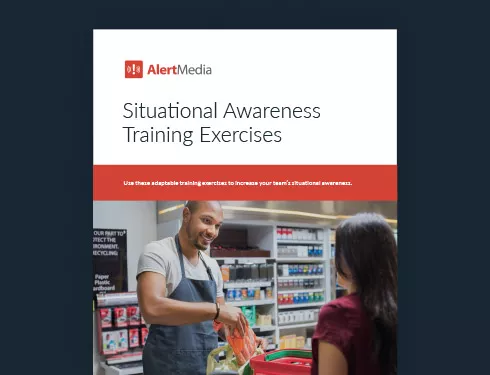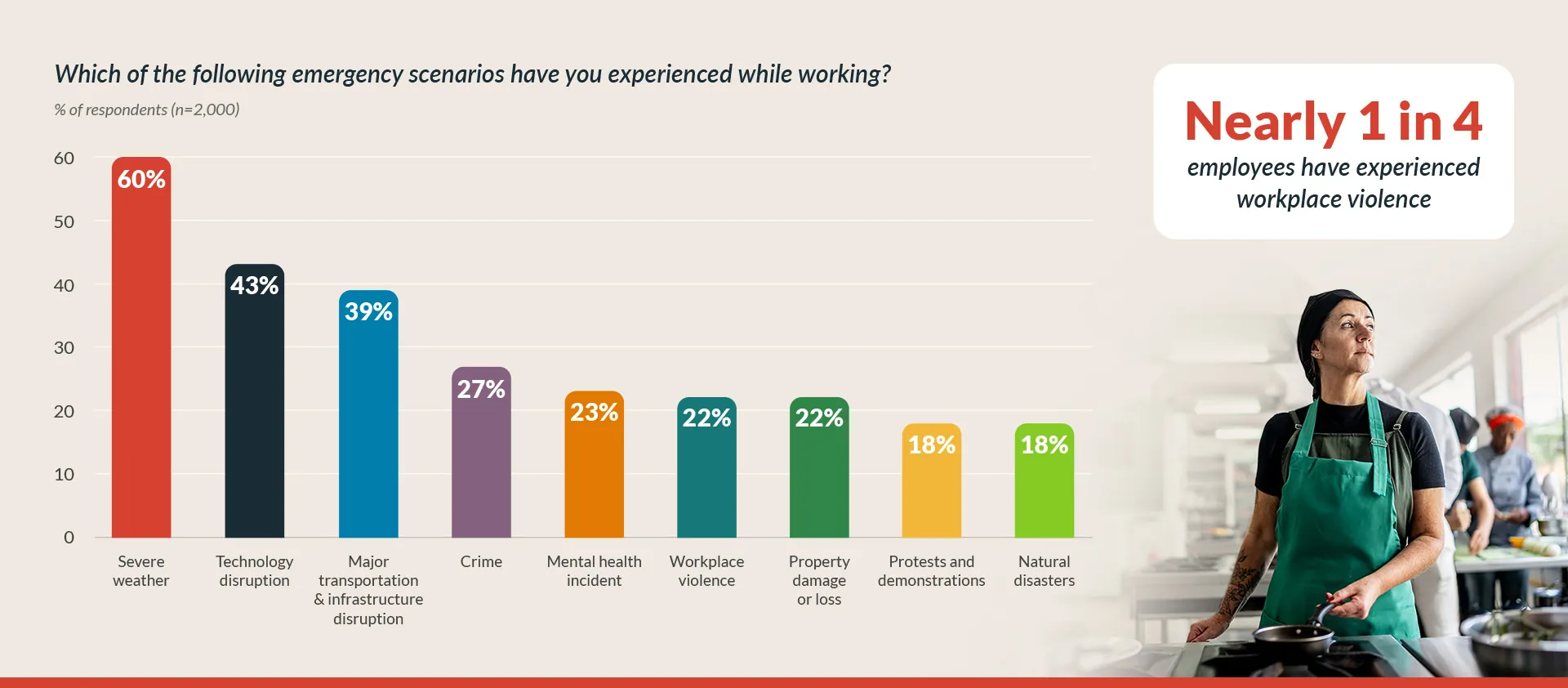
How to Create a Workplace Violence Prevention Plan
Preventing workplace violence starts with knowing how to identify risks. This post will cover how to create a plan to prevent workplace violence and improve workplace safety overall.

Workplace violence is a tragic reality for nearly a quarter of the American workforce. Roughly one in four U.S. full-time employees reported experiencing workplace violence according to the 2024 State of Employee Safety Report. The National Safety Council reports assaults are the fifth leading cause of workplace deaths and resulted in more than 57,000 injuries in 2021 and 2022—and more than 500 fatalities in 2022 alone. These statistics don’t count the estimated 25% of workplace violence that goes unreported.
While a massive altercation might be extremely rare, many employees have experienced clashes caused by opposing personalities, leadership style differences, or personal issues. Stressful situations such as employee layoffs or firings can also cause people to lash out, and aggressive customers or members of the public can cause severe harm without mitigation practices. Between the rising rate of violence and the increasing legal requirements on businesses, it’s prudent for organizations to do everything in their power to reduce the risk of escalation.
Fortunately, there are concrete and practical actions employers can take to help prevent these events from impacting their place of business. This post will cover how to create a plan to prevent workplace violence, fulfill your legal obligations, and improve workplace safety overall.
Situational Awareness Training Exercises
What Is Workplace Violence?
Violent acts in the workplace take many forms, ranging from an offensive comment or verbal abuse to physical assault, rape, or workplace homicide. These incidents are generally caused by an employee, former employee, personal relation to an employee, contractor, vendor, or customer. Incidents of workplace violence may occur inside or outside of the office (i.e., parking lots or at company happy hours), as well as in remote work sites or locations.
OSHA defines workplace violence as “any act or threat of physical violence, harassment, intimidation, or other threatening behavior that occurs at the worksite.”
The four most commonly occurring types of workplace violence are:
- Criminal intent by an unaffiliated party, such as robbery or trespassing
- Customer or client aggression towards a place of business or its employees
- Worker-on-worker violence, including issues between co-workers or contractors
- Personal relationship—for example, a partner, ex-partner, or family member of an employee
Mitigating these different types of violence requires a few different approaches, but they can all be managed with a comprehensive workplace violence prevention plan.
April is Workplace Violence Prevention Awareness Month
The National Institutes of Health recognizes April as Workplace Violence Prevention Awareness Month, “with the goal of increasing awareness to recognize, prevent, and respond to workplace violence.”
Download the 2024 Safety Calendar Template to plan for this and other significant observances.
Why Every Business Needs a Workplace Violence Prevention Program
Workplace violence prevention is something business leaders can’t ignore. Both OSHA and the FBI cite employers’ legal and ethical obligation to promote a work environment free from threats and violence (also known as their duty of care responsibility). There are also states enacting new laws around workplace violence prevention.
California, for example, recently passed Senate Bill 553, which expands on several existing laws requiring California employers to prevent and prepare for violence in the workplace. SB 553 does this by expanding restraining order guidelines, mandating employee training, and establishing structured planning and recordkeeping guidelines. This includes having a thorough workplace violence prevention plan.
The most obvious and important benefit of having a workplace violence prevention plan is saving lives and reducing injuries. Beyond that, having a prevention plan in place will:
- Demonstrate a corporate commitment to providing safe working conditions
- Ensure a swift response without confusion about what should be done and by whom
Unlike natural disasters such as hurricanes and tornadoes, there’s no advisory system in place to detect and monitor the potential for violence impacting your business. Even the most comprehensive prevention plan can’t guarantee absolute protection, but there are concrete actions you can take to lower the risks.
Industries at the highest risk
Workplace violence can affect any employee in any industry, but there are a few fields with significantly higher rates of incidents. The NSC reported that in 2021–2022, service-providing industries accounted for 98% of assaults at work, with 73%—nearly 47,000 incidents—falling under healthcare and social assistance. Retail also faces a high rate of violence, with 47% of in-store retail workers reporting physical or verbal violence on the job.
These industries have significant exposure to the public, which puts them at a high risk of customer/client aggression. They also have highly stressful jobs that require long hours. Since there is no way to limit exposure to potentially violent customers/patients, employees working in these industries rely on their organizations to put prevention and mitigation strategies in place to protect them from harm.
3 Elements of a Successful Workplace Violence Prevention Plan
A successful plan is three-pronged and includes:
- Workplace violence prevention training programs to teach employees about recognizing the potential for violent behavior
- A clear process for incident reporting, including documenting threats, violent incident logs, and other concerns, as well as training records
- Intervention measures and training programs to enable employees to evaluate and combat issues properly
The best way to prepare your business is by attempting to prevent the event completely. However, knowing how to prepare for and respond to violent conduct is critical to an effective response if violence does take place. Follow these steps to prepare your business and safeguard your workforce in the face of violent conduct.
Workplace Violence Mitigation Strategies
1. Perform a risk assessment
Conducting a thorough risk assessment of your workplace is the first step towards prevention. Pinpoint any vulnerabilities at your office or worksite that need to be addressed. Workplace violence statistics indicate some factors that may increase the risk of violence, including gender and occupation.
- Women are more vulnerable to attack, especially domestic violence, in the workplace.
- Occupations such as healthcare workers, teachers, social workers, delivery drivers, and taxi drivers are at higher risk.
- Conditions such as working alone, in isolated areas, at night, or where alcohol is served are also risk factors for aggressive behavior.
- Other vulnerabilities may include any type of situation that could lead to violence at work, such as inadequate security, lack of staff, physical security threats, or the perception that acts of violence are not taken seriously.
Your organization should regularly assess and monitor these and other workplace violence hazards. If there have been previous incidents, study them to learn where there might be gaps in your current policy (if you have one). How were the incidents handled? What systems were implemented to avoid future incidents and are they sufficient?
2. Establish a strict policy against workplace violence
Your company’s workplace violence policy is a public commitment to a safer working environment for all your people. Your policy should include a clear statement that violence is unacceptable, will not be tolerated, and that the organization is committed to preventing, controlling, and eliminating violence through specific procedures and disciplinary actions. But Matt Doherty, Managing Director of Workforce Risk Management at Sikich, spoke in an interview on The Employee Safety Podcast about the risks of highly punitive, zero-tolerance policies. “There’s a lack of reporting because of the punitive nature of the policies that say workplace violence won’t be tolerated,” Matt explains. “Therefore, [an employee’s] reaction is they don’t want to get involved.” Open communication is critical for encouraging reporting of suspicious or hazardous behavior.
The policy should clearly outline your process for reporting incidents, threats, or concerns, as well as for investigating the event promptly and privately. Describe what actions staff and managers should take if a violent incident occurs. For example:
- What should a staff member do if a customer verbally abuses them?
- Do they have the right to ask that person to leave?
- Can the employee leave their workspace?
- Should they call the police?
In addition, let people know what specific measures and actions you’re taking as a company to limit threats of violence, whether it’s background checks for new employees or banning firearms on company premises. Be sure to involve people at all levels in creating and supporting your plan, including employees, managers, and C-suite executives.
3. Foster a supportive working environment
You and your Human Resources department must make employees feel heard and supported at work. Establishing trust and confidentiality will go a long way in letting employees know they can report incidents and concerns without fear of retaliation or reprimand. Here are a few ways you can foster a non-toxic work environment free from bullying, harassment, and physical harm:
- Encourage your employees to speak up about their concerns, especially those involving threats to their personal safety or imminent danger.
- Create a culture of acceptance of individual differences.
- Offer communication training to provide employees with tools for non-violent conflict resolution.
- Look out for hazards (including stress and negativity) in the workplace and take actions to correct them.
- Offer benefits, such as employee assistance programs, to ease stress and support mental health for all employees.
4. Create an emergency response plan
While no employer wants to imagine a violent incident involving their business or employees, not having a plan is not an option. A clear plan is critical to protect your people if tragedy strikes. Map out essential elements of your plan:
- Implementing an emergency communication system: Information is vital in an emergency. An emergency communication system lets you inform all employees of an emergent situation, provide action plans, and check in on their well-being via multiple channels. Employees—particularly those who often work alone, such as security guards, social service workers, and home healthcare workers—can also signal for help via an employee safety monitoring app.
- Identifying evacuation routes: Ensure people know where all exits are located and any special evacuation instructions for crisis response. The more prepared your people are, the quicker they can get to safety.
- Establishing rendezvous points: As with a fire evacuation plan or a disaster response plan, your workplace violence prevention plan should include a predetermined meeting point for employees to gather once the coast is clear. You can use an emergency notification system to let employees know when it’s safe to reenter the building.
- Providing appropriate response strategies: Run, Hide, Fight is a prominent defense strategy taught for individual response to an active shooter situation or other violent conflict scenarios. Combine this approach with your coordinated response, including calling 911 and law enforcement ASAP.
- Conducting drills and raising awareness: Instead of just sending a company-wide email, take time to communicate the plan with your teams in an open discussion format. Allow them to ask questions and ensure they understand what to do in various situations. Though intense for participants, active shooter drills are worth it if they prevent loss of life.
5. Empower your teams
Of course, commitment to preventing workplace violence goes beyond simply creating a plan. It requires allocating resources to ongoing training sessions and awareness around workplace violence prevention.
We spoke to Bryan Strawser, Principal & Chief Executive at Bryghtpath, on The Employee Safety Podcast, and he weighed in on how to improve your workplace prevention program. The key, he says, is to make sure everyone understands their role. “For team leaders and managers, they need to understand how to manage the threat of workplace violence and how to make sure those reports get escalated. For the average everyday employee, it’s about understanding what behavior is acceptable and not acceptable and how to report that, regardless of who might be engaging in that behavior.”
Here are a few ideas to train employees to navigate workplace violence prevention:
Being able to register red flags and potential risks can help employees avoid or circumvent a violent situation. Warning signs that may indicate the potential for violent action include:
- Abnormal behavior
- Depression
- Aggression or hostility
- Mood swings
- An apparent decline in mental health
- Paranoia
- Dependency on drugs and/or alcohol
Periods of stress within the company or an individual’s personal life may also trigger aggressive behaviors towards others.
Company-sponsored employee first aid training has multiple benefits. With proper first aid knowledge, employees can help save lives in the event of a crisis. Whether the unthinkable is a natural disaster or an active shooter, first aid skills serve a critical need. They can also help their families at home or others in the community.
Empowering your people doesn’t stop after the event is over. People may need extra support after a traumatic event. Support their recovery process by providing resources, such as time off, trauma counseling, or financial assistance with medical bills.
Spreading Awareness and Prevention Beyond the Workplace
While you never hope to use these emergency measures, it should give you some peace of mind to know your organization is prepared. Also, doing your part to mitigate workplace violence through prevention policies, awareness, and training will have a lasting impact on your organization, your employees, their families, and the community.





